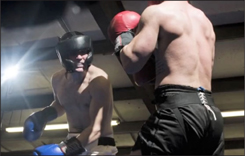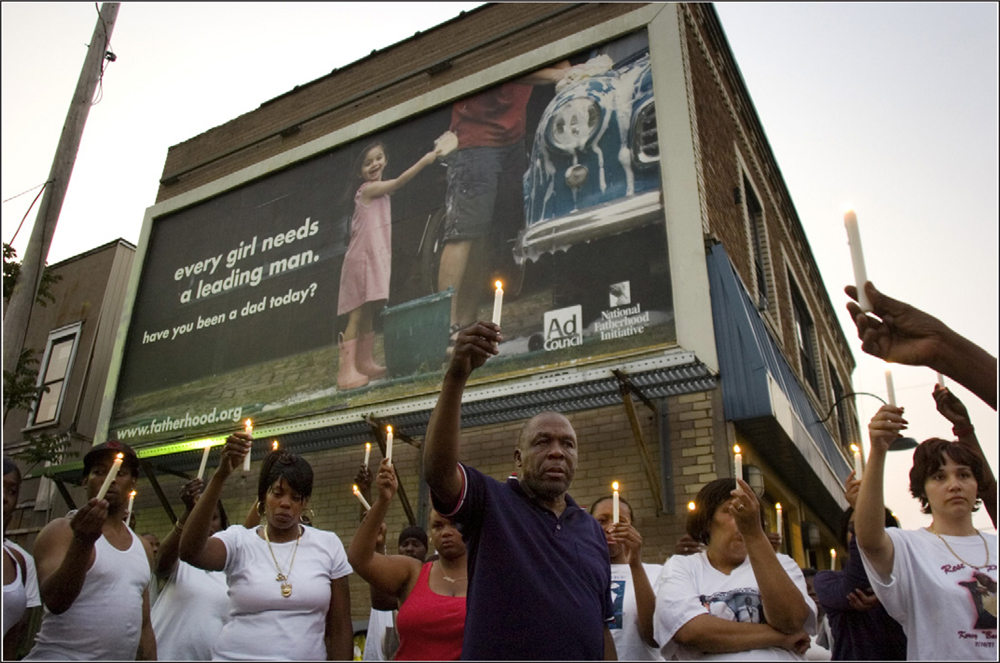CHAPTER 3
Successful Story Topics
▲ Alvin Stamper, 26, defends his title as the tobacco cutting champion at the Garrard County Tobacco Cutting Competition. Contests make good topics for multimedia and videos because they have a natural story arc built in. ![]()

(Photo by David Stephenson/ZUMA Press)
This symbol indicates when to go to the Video journalism website for either links to more information or to a story cited in the text. Each reference will be listed according to chapter and page number. Links to stories will include their titles and, when available, images corresponding to those in the book. Bookmark the following URL, and you’re all set to go: http://www.kobreguide.com/content/videojournalism.
Not every topic lends itself to a videojournalism story—some are better suited to being told in print or on the radio. So how do you pick a topic that will compel viewers to watch your video?
Ironically, poor people or people touched by war make excellent subjects for compassionate videojournalists and audiences alike. Poverty’s sting and the ravages of war touch the hearts and minds of viewers everywhere. People overcoming adversity, handicaps, and other seemingly insurmountable problems also make good material for visual storytelling.
Luckily, life consists of more than the tragedies of poverty and war. The stories that underlie the daily lives around us can make for compelling videojournalism, as well.
CONTESTS, GAMES, AND SPORTS
Competitions have built-in story arcs. They always have a protagonist and a natural timeline from start to the finish. In this respect, it is relatively easy to find the narrative because the conflict is so obvious. The challenge is the game and conflict is inherent in the competition. The outcome is unknown until the winner and loser emerge.
David Stephenson’s story “Cutting Through the Competition” follows a tobacco-cutting competition that pits two experienced tobacco farmers against each other in a unique race. The story builds with edgy tension as the two farmers labor shirtless in blazing summer heat, each working madly to cut his respective rows more quickly than the other.
“The tobacco cutting contest was perfect for a narrative,” Stephenson says. “There is a beginning, middle and end, already spelled out for us. There is obvious conflict and resolution. We found a character that added grist to the whole story because of a sympathetic twist—if he won, Alvin’s’ winnings would help pay fees for a child he hoped to adopt. Really, it was a no-brainer in terms of having a competition and character. We almost couldn’t go wrong”.
Obviously, as seen in the previous example, competitions don’t have to feature only traditional sports. In fact, the more unconventional the competition, the more likely it is to draw in viewers. There are TV programs and in fact whole TV channels devoted to covering alternative competitions: hot dog eating contests, lumberjack events, and strongman competitions are fast gaining audience attention.
▲ Cutting Through the Competition. Spectators try to peer over the tops of tobacco plants to get a glimpse of the competitors at the Garrard County Tobacco Cutting Competition. During the tobacco harvest at the end of every summer, men gather to compete against each other to see who is the fastest at cutting the crop before it is hung in the barns to cure. From planting to the auction house, tobacco remains one of the most labor-intensive crops, and the hands and backs of laborers have yet to be replaced by machines.

▲ Alvin Stamper, 26, slices tobacco stalks at their base and spears them onto a stake. Stamper’s grandfather, left, is his “walker” and helps by providing both stakes and words of encouragement.

▼ Daniel Edgington, left, and Alvin Stamper rest after a grueling hour of competition. ![]()

(Photo by David Stephenson/ZUMA Press)
Sports Can Follow a Natural Story Arc
Many times, sports and competition stories will have a second storyline within the obvious narrative. For example, Stephenson’s weaves into the tobacco-cutting contest facts about the history of tobacco farming and the decrease in small tobacco farms in Kentucky. “If you can add a subplot to the story,” Stephenson says, “all the better”.
Western Kentucky University photojournalism students Bethany Mollenkof and Ben Severance produced a story on a fraternity boxing match called “Sigma Chi’s Battle of the Greeks.” The story, which could have easily been a general story about the event, covering the uppercuts, right- and lefthanders and drunken fans, instead featured just two of the boxers, keeping its focus on their fights.
Mollenkof explains, “Ben and I had been to the event in the spring of the previous year. We both thought this should be a multimedia story, but at the time we didn’t have the skills. So we filed it in the back of our minds. We had met one of the fighters, Evan Goddard, that previous year. We remembered to contact him when we were ready to do the story. We knew Evan could be just the guy we needed to put a narrative story behind the event”.
The two producers understood they needed to focus on a particular match to make a decent narrative arc for the story. “When you’re watching the fight, you know there’s going to be a winner and a loser. We wanted to follow Evan, the favorite to win, and another fighter who was an underdog,” Mollenkof says. “Obviously there is going to be a definite ending to the story. There’ll be conflict, action, characters, and resolution. We had all the pieces of the puzzle. We knew if we put them together right, we would produce a compelling narrative”.
This piece they made was a classic. It was David and Goliath all over again, good versus evil, new versus old, strong versus weak. “The better the characters are, the better they’ll carry the narrative,” Mollenkof says. “Luckily, we remembered Evan from the year before. He was intense, driven, and way popular with the girls”.
◀ Prove Yourself. Evan Goddard (left) speaks with confidence about the upcoming fight.

(Photo by Ben Severance, The Herald)
Derek Mundt is concerned about his chances in the upcoming fight, where he will face a seasoned opponent.

(Photo by Ben Severance, The Herald)
◀ The fight pitted an inexperienced boxer, Derek Mundt, against a much more seasoned one, Evan Goddard.

(Photo by Ben Severance/Bethany Mollenkof, The Herald)
▼ Members of Pi Kappa Alpha cheer on their fraternity brothers at the annual Sigma Chi Battle of the Greeks boxing event. ![]()

(Photo by Bethany Mollenkof, The Herald)
Severance notes, “Evan represented a prototype of person which exists everywhere, on most college campuses. Derek Mundt, Evan’s challenger, was a particular type, as well. Derek was a first-year frat brother, had never fought before, and was unsure of himself. Evan was a cocky, arrogant, and popular jock. Derek was the clear underdog”.
▶ The overhead camera captures the moment the referee declared Goddard the winner.

(Photo by Ben Severance/Bethany Mollenkof, The Herald)
▶ Evan Goddard, wearing the title belt, bumps knuckles with Derek Mundt after defeating him in the ring. “At the end, there’s a reconciliation. After Evan beats Derek, he says, ‘Good job, Derek, you tried, I’ve been there,’ and that was our story,” says producer Mollenkof.

(Produced by Bethany Mollenkof and Ben Severance)
So once the team of producers settled on their characters, they began the process of interviewing and shooting. While doing so, they went on searching for just that hidden message that would make the story sing. “We basically knew what we thought about them, but we were constantly trying to peel back layers,” Mollenkof tells us. “Once we had talked to Evan, we came to realize that he is who is he because he used to be more like a Derek. When integrated, that revelation gave the story a personal twist and set it apart from the stereotypical fight story level. At the end, there’s a moment of reconciliation,” Mollenkof says. “After Evan outboxes Derek, he meets him outside of the ring and tells him, ‘Good job Derek, you tried. I know. I’ve been there.’ That statement lent the perfect amount of emotion to our story”.
The story “Prove Yourself” is indeed a tale about a boxing match. But it is much more a narrative about two characters. They are both vying for the same title, but they are doing so for completely different reasons. This element alone takes a simple boxing match tale and turns it into a much more complex and thought-provoking story for a larger audience. It’s about daring to challenge oneself. Straightforward sports stories almost always benefit from a little in-depth reporting and interviewing.
DRAMATIC TRANSFORMATION THROUGH RECOVERY
Rick Loomis, a photographer at the Los Angeles Times, produced a story called “Breaking the Chains of Addiction,” which tells about a few recovering addicts of various sorts who have come together for rehabilitation at a treatment center. Though they have come from multifarious backgrounds and lifestyles, their goals are the same—recovery.
The rigorous process of recovery from addiction provides a natural narrative. The subjects have a problem, they have a goal, and there is a path to that goal. The outcome is unknown. The suspense of not knowing the outcome is largely what hooks the viewer.
“Each character had hit rock bottom, and each one’s rock bottom was different,” Loomis explains. “One woman had a DUI and had killed someone. She couldn’t find a way out for a long time. The center was using art therapy to help her. Each person was trying to grasp at something. I interviewed about eight people for half an hour each”.
Loomis found that recovery in and of itself was a challenge for the characters. Some had physical challenges. Others had mental or psychological challenges. Loomis struggled, wondering what format he would use to tell the story. “Originally, I wanted to do one portrait with one piece of audio interview. But I felt it wasn’t going anywhere and wouldn’t drive a viewer to want to see it all the way through. Frankly, back then, it didn’t even make me want to listen to it. Then I started cutting the audio down to some choice quotes that were sending chills down my spine,” Loomis says.
▲ Breaking the Chains of Addiction. Beit T’Shuvah, a mid-city Los Angeles synagogue and rehab center catering to a mostly Jewish clientele, leans on spirituality and the Torah to heal addiction. The clients include heroin junkies, alcoholics, sex addicts, and gamblers. ![]()

(Photo by Rick Loomis, Los Angeles Times)
“I just pursued heroin into the gates of hell”.
“Look, if I get high in the next two years, I go back probably for life”.
“From the moment my eyes would open, I would start drinking, and I wouldn’t stop until I passed out”.
“I knew that if I kept using I was going to die”.
These are the kinds of arresting quotes that engage an audience and compel people to want to continue to follow a narrative. The quotes are inspiring. They make real what had only been hinted at in the introduction of the piece.
Loomis decided to bookend his story about the rehab center with portraits and short powerful quotes. It’s an effective way to introduce the characters and make the audience wonder about each one’s story and struggle.
CHANGING A LIFE
Chang Lee of the New York Times publishes a regular series called “Second Chance,” which profiles people in transformation of some sort in their lives. As he explains in the project summary, the stories are “portraits of journeys to truthful self-existence”.
Some of his subjects make a transformation of career or lifestyle. One profiles a woman who chose to change her gender. The piece takes place during the time she is completing sex-change surgery. Like Loomis’s story following a recovery process, Lee’s stories aim to follow subjects through various kinds of transformations, which create the narrative that keeps an audience hooked throughout the pieces.
DEATH AND DYING
Stories of death are almost always dramatic, and audiences are naturally drawn to them, especially when produced thoughtfully and tastefully. Because death, like birth, is perhaps one of the only universal experiences for all people, audiences are curious to learn about others’ experiences with death and dying.
Sonya Hebert’s series for the Dallas Morning News, “At the Edge of Life,” follows families and health care professionals as they learn to use palliative care to help those who are dying.
“When I first got the assignment, I thought, ‘Who cares, everyone dies,’ but after some research I realized, wow, this story has potential to be really powerful because everyone experiences it and everyone hurts from it,” Hebert says. “There are literally tons of stories out there, and I saw it as my job to help link them into this large project about death and dying.” Hebert indeed met the challenge by finding universal themes like love, hope, and despair that were present in the stories. Rather than focus on the specific experiences of each family, she uses the experiences to focus more on the universal themes with which her audience can best connect.
“If you look at good literature,” Hebert says, “it works partly because you can relate to the characters. You think, ‘Wow, I can imagine that happening to me.’ You walk in the characters’ shoes, and feel their profound emotion. Human experience translates across historic, economic, social, and other barriers. You especially relate to the characters’ experiences when they touch a nerve in you or are otherwise brought close to home”.
▲ At the Edge of Life. Miles Hoffman tenderly embraces his wife, Christina Hoffman, at Baylor University Medical Center in Dallas. Christina Hoffman has Huntington’s disease. The Baylor palliative care team is helping Miles find solutions to meeting Christina’s needs as the end of her life draws near. Miles continues to struggle with the knowledge that he is no longer able to take care of her. ![]()

(Sonya Hebert, Dallas Morning News)
◀ Second Chance. Terry Cummings prepares to go to work in Montclair, New Jersey, before sex reassignment surgery. ![]()

(Photoby Chang Lee, New York Times)
This is why finding universal themes in any story you’re pursuing is so crucial. You want to appeal to a large audience. Always seek to connect viewers with your characters’ real experience. Themes of this type invite people to become immersed in a narrative.
▲ Baby Feras. A hospital with facilities to treat Baby Feras’ heart condition was only an hour’s drive away from his parent’s home in Gaza, but it might as well have been across an ocean. His families requests for treatment were turned down—only an “emergency” qualified. Unfortunately, the child’s condition deteriorated so rapidly that it became an “emergency.” His paperwork arrived too late to save him. ![]()

(Produced by Casey Kaufman, Al Jazeera International)
Casey Kaufman produced a story for Al Jazeera International, about a little boy living in Gaza, “Baby Feras,” who Deseperately needed surgery to repair two holes holes in his heart. Though the Israeli hospital was only an hour’s drive from his home, in the end he was unable to have surgery in time because of the Israeli blockade.
The story follows the family on a natural narrative as they repeatedly struggle to get the baby into the hospital in Israel, where he can be admitted for emergency treatment only. Finally, after far too long, they are granted permission. But the permission arrives too late. Baby Feras dies while awaiting permission to cross the border. An unknown outcome frequently contributes not only to sparking but also to holding onto an audience’s attention.
LOCALIZING A NATIONAL PROBLEM
Brian Kaufman’s Detroit Free Press story “Carrier of the Economy” presents a micro view of the economic crisis through the eyes, experiences and observations of a postal delivery worker.
This postman says that he is witness to the downturn in the economy via the types of mail people receive: bank notices, advertisements for legal services, and certified letters. This story, which has an ordinary person as its main character, is enlivened by compelling videography: clever camera angles, unusual shots, quick-cut editing, and smooth transitions.
HUMANIZING LARGE ISSUES
The problem with many stories about broad issues—be they the failing economy or the rising homicide rate—is that a large audience may find them dull. Many members of the mass-market audience rarely get beyond the big picture news value of a story. The videojournalist’s challenge is to stimulate the public by infusing the work not only with human appeal but with clever videography as well.
One morning in his own newspaper, Will Yurman, a staff photographer at the Rochester Democrat & Chronicle, read a brief 102-word story about one of about fifty homicides in his city. “It contained the barest of facts. A man was found dead at 7:00 a.m. There were no suspects,” Yurman remarks.
A few days later, Yurman was assigned to cover the memorial for the slain man. “So I get to the vigil early, and his sister was there outside the house. I start talking to her and naïvely say, ‘I’m shocked at how little we wrote about your brother.’ She said ‘I’m not surprised, no one cares about a black man from Jamaica.’ She didn’t say it angrily and wasn’t blaming me, or the paper, but was rather saying sort of ‘The grass is green, the sky is blue, and no one cares about a dead Jamaican man.’
▶ Carrier of the Economy. A postal worker’s observations on changing trends in mail delivery encapsulate the condition of the economy. ![]()

(Produced by Brian Kaufman, Detroit Free Press)
“I couldn’t let go of what she told me. I drove back thinking, ‘We should care.’ The facts are that Rochester has a fairly hefty homicide rate. We’ve averaged 50 per year. People like Ian Crawford deserved to be remembered,” Yurman explains. “So,” says Yurman, “I conceived this idea to do a project about who these homicide victims were. I didn’t want it to be about the crimes, but rather about who they were as people and the effects their deaths had on the family and friends who survived them.
“I pitched it to my editors, who decided it would become a web-only project. So for one year, every time there was a homicide, I reached out to the victim’s family. I often went to funerals and vigils. Only four or five families politely declined to participate. The majority was totally open to the idea of participating in the project”.
Yurman’s story answers the question about why you should care about the homicide statistics of Rochester, New York. After seeing the story, when you read the numbers and statistics, you cannot help but care and feel the chagrin of the characters. The numbers are hard enough to wrap your head and heart around. But then how do you transform that into a human story that shows the humanity behind the numbers?
“I think at the very least,” Yurman says, “it makes readers stop and think when they actually see the numbers. Many people’s eyes may glaze over when you report the 27th homicide of the year, or low graduation rates, or high rates of poverty. After all, if you live safely out in the suburbs, such statistics only represent more negative news from your local newspaper. Why should I care about those people? Well, when they see my story, they will care about Alpha Lee and how she lost her son because people in the suburbs have sons and brothers they might lose, too. The story appeals on a visceral level to every man and woman, regardless of their social status or geographical location”.
◀ Not Forgotten. Sandra Porter consoles her niece, Tasha Gano, Shamar’s half-sister, at calling hours for Shamar Patterson at the D. M. Williams Funeral Home.

◀ Beverly Dunbar of Rochester says goodbye to Christopher Dunbar at his funeral in the Faith Deliverance Christian Fellowship Center in Rochester.

◀ Pall bearers carry the casket from the funeral home for homicide victim Ramon Burgos.

▼ Mourners gather at a candlelight vigil for homicide victim Korey Ellis. ![]()

(Photos by Will Yurman/Democrat and Chronicle)
HUMOR
Multimedia and videojournalism are built for humor. Think of the times your friends have sent you a video on YouTube that you laughed at until your sides hurt. In fact, you laughed so hard you couldn’t resist forwarding it to a dozen other people.
Powderpuf football is a high school tradition all across the U.S. Girls and boys switch traditional roles for one game. The girls play football and the guys cheerlead. While at the Roanoke Times, this writer produced a story called “Powderpuff Cheers: Hidden Valley Boys Dress the Part.” The story, centered on the cross-dressing boys, was full of funny one-liners. When referring to his false “breasts”, one male student said to a girl, “Balloons as boobs look pretty big and real. But I think rolled-up socks have the feel down right”.
▲ Students hold a fellow powderpuff cheerleader during their game. “We’re just like sisters,” says one of the male cheerleaders.

▲ Powderpuff Cheers. A senior powderpuff cheerleader checks the location of his balloons before the game. Girls and boys switch traditional roles during a powderpuff football game.

▼ Cheerleader for a day Eric Finch applies some lipstick in the mirror before leaving for the game. Finch and several senior friends acted as cheerleaders for the annual powderpuff game.

▶ Cheerleader Eric Finch (left) gets some help adjusting his rolled-up socks in a bra from teammate Jacob Andrews (right) at Andrews’s home before heading off to lead cheers for the annual powderpuff football game. ![]()

(Josh Meltzer, Roanoke Times)
Kyle Green of the Roanoke Times produced a story on a woman who runs a dog poop collection business. Green’s questions led to some funny answers. The subject tells Green, “I don’t charge more for small dogs than I do for large dogs because it actually is harder to find small dogs’ poo than large dogs’. Here you are searching around the yard hoping you won’t step in it, but that is the way you find it. Large dogs, you can’t miss it”.
The answer to another question produced this insightful response. “I am one of the few people in town … that can come home and say, ‘You can’t believe the crap I put up with today’” followed by this observation on life: “There are only so many hours in the day. How many do you want to spend picking up your dog’s poop?”
THE UNUSUAL AMIDST THE ORDINARY
Amidst the plethora of news stories online, our audiences are always looking for something to catch their attention. Many times, it can be the slightly oddball or different slant on a subject that does the trick. Everyone has a story. But not everyone’s story is appealing to a large audience. As a videojournalist, it’s your job to ferret out captivating people and appealing stories so as to make your work stand out above the masses of other alluring stories crowding the media today.
Todd Heisler from the New York Times finds fascinating people in his weekly “One in 8 Million” multimedia series. Each week, he profiles and tells the story of one New Yorker. His characters range from an urban taxidermist to a woman who loves sadomasochistic sex. There are veterans, sports fans, flirts, boat dwellers, gang members, detectives, criminals, gardeners, doormen, and mozzarella makers. The photography, all in black and white, is extraordinary, and the pacing is perfect for each story. It allows the audience to connect with one individual who is not a celebrity—just a single New York person (out of a city of eight million) who has something engaging or unusual to show the world.
▲ Dooty Diva. Katie Halsted has created a business called “The Dooty Diva.” Job description? “Professional pooper scooper.” Katie’s business involves traveling to customers’ homes and removing, well, dog poop. In the photo, Katie walks with her own three dogs. It is stories like Katie’s where inherent humor grabs and holds the attention of an audience, shocking them with witty lines and satirical comments. ![]()

(Photos by Kyle Green/Roanoke Times)
◀ Stefanie Rinza: The Animal Rescuer. One in 8 Million tells the stories of New York characters in sound and images. Stefanie Rinza is one of those characters. ![]()

(Photos by Todd Heisler, New York Times)
